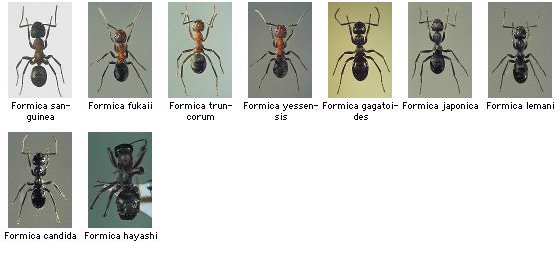
|
genus
|
Formica
|
 |

|
|
Japanese Name
|
Yama-ari-zoku
|
Original Reference
|
|
Linnaeus, C. (1758) Systema Naturae per regna tria naturae, secundum classes, ordines, genera, species, cum characteribus, differentiis, synonymis, locis. Editio 10. 1: 823 pp. Holmiae.
|
Synonym
|
|
Formicina Shuckard in Swainson & Shuckard, 1840,
Raptoformica Forel, 1913,
Serviformica Forel, 1913,
Coptoformica Mźller, 1923,
Neoformica Wheeler, 1913a,
Adformica Lomnicki, 1925a,
Iberoformica Tinaut, 1990,
|
Description
|
|
Worker almost monomorphic; total length around 3.5 - 7 mm. Eyes relatively large. Ocelli distinct. Antennae 12-segmented. Frontal area distinctly margined. Frontal carinae sharply raised but short; a little divergent posteriorly. Mandibles rather slenderly triangular; masticatory border with 5 - 12 denticles. Maxillary palpi 6- or sometimes 5-segmented; labial palpi 4-segmented. Metanotal groove distinct. Propodeum distinctly lower than promesonotal dorsum. Propodeal spiracles slit-like and situated away from the posterior margin of the propodeum. Petiole transversely scale-like in form, with a sharp carina ventrally. Hind tibia with setae in 2 rows. The female is much larger than the worker: metanotal groove indistinct; fore wing with median and cubital cells. In the male: antennae 13-segmented; the scapes long; external genital organs large; cerci developed.
|
|

|
Remarks
|
|
The species of this genus nest in the soil. Some also build mounds of dead twigs and leaves. The main food items are insects, the secretions of aphids, and floral nectar, for which workers forage on trees, herbs and grasses. Formica is distributed in the Palearctic and Nearctic regions. About 120 species have been described. The nine Japanese Formica species were formerly classified in four subgenera, Raptiformica, Coptoformica, Formica s. str., and Serviformica, according to Myrmecological Society of Japan Editorial Committee (1988). In the present edition we treat all these subgeneric names as junior synonyms of Formica.
|
References
|
|
- Swainson, W. & Shuckard, W.E. 1840. On the History and Natural Arrangement of Insects. 406 pp. London
- Forel, A. 1913. Notes sur quelques Formica. Ann. Soc. Entomol. Belg., 57: 360-361.
- Mźller, G. 1923. Le formiche della Venezia Guilia e della Dalmazia. Boll. Soc. Adriat. Sci. Nat. Trieste, 28: 11-180.
- Wheeler, W. M. 1913. Corrections and additions to "List of type species of the genera and subgenera of Formicidae". Ann. N. Y. Acad. Sci., 23: 77-83.
- Lomnicki, J. 1925 ("1924"). Przeglad polskich gatunk—w rodzaju mr—wki (Formica LinnŽ). Pol. Pismo Entomol., 3: 151-182.
- Tinaut, A. 1990. Descripci—n del macho de Formica subrufa Roger, 1859 y creaci—n de un nuevo subgŽnero (Hymenoptera: Formicidae). EOS Rev. Esp. Entomol., 65: 281-291.
- Bolton, B. (1995). A new general catalogue of the ants of the world. 504 pp. Harvard University Press.
- Myrmecological Society of Japan, Editorial Committee (ed.) (Ed.). (1988). A list of the ants of Japan with common Japanese names. The Myrmecological Society of Japan, Tokyo.
|
Editor
|
|
Original text by Rikio Sonobe and Keiichi Onoyama. English translation by Keiichi Onoyama, edited by Robert W. Taylor. Revised by Masashi Yoshimura.
|
|